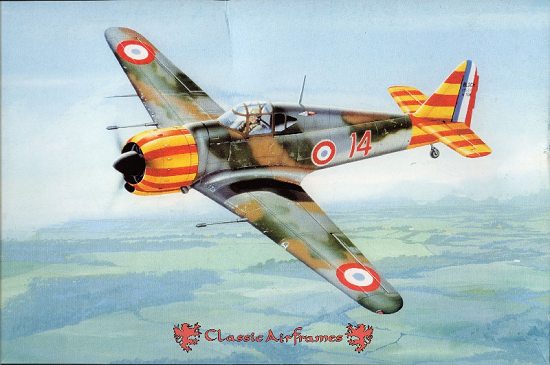
|
KIT: |
Classic Airframes 1/48 MB.155 |
|
KIT # |
423 |
|
PRICE: |
$29.95 MSRP |
|
DECALS: |
Two aircraft |
|
REVIEWER: |
|
|
NOTES: |
Short run with resin and vac parts |

|
HISTORY |
France has always managed to produce very interesting aircraft, especially in the pre-war years. One successful builder was Marcel Bloch with his Bloch MB-151(-2, -5, -7) line of fighters. After the development of the MB-152 fighter, Bloch (which had been absorbed by the Société Nationale de Constructions Aéronautiques du Sud-Ouest, or SNCASO), began to study a new aircraft, which would encompass a lot of parts from the MB-152, but offered more speed, range and better manoeuvrability. The new aircraft had cleaner lines, a slightly wider wing, but the cockpit was moved further aft to install a fuel tank in order to increase the range. The engine was quite similar to its predecessor. Armament consisted of a pair of belt-fed 20mm guns (the first to be installed in a French production fighter) and two 7,5mm MAC 1934 M 39 machine guns, but it could also carry only six of the machine guns, without the canons. Another first was the use of an armoured windshield.
Production started up, but no machines ever made it to an operational unit, although GC I/1 got very close to laying its hands on the birds. After the capitulation of June 25th, the production was stopped, but after the Germans moved back to the line of demarcation, production fired up to complete the machines already on the line and they were delivered to Vichy’s Groupe de Chasse where they flew alongside MB-151s and MB-152s. After the majority of the groups received their Dewoitine D.520, the MB-155 where sent to GC I/8 at Montpellier (no, not Montpellier in Vermont!). The disbandment of the Vichy forces on November 27, 1942 saw the MB-155 pass into the hands of the Luftwaffe (for use as advanced fighter trainers).
|
THE KIT |
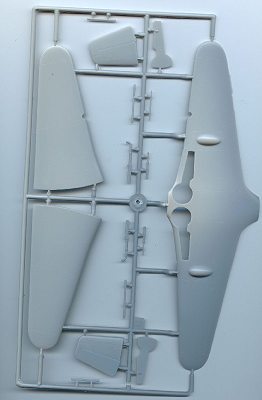 |
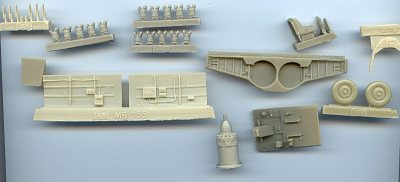 |
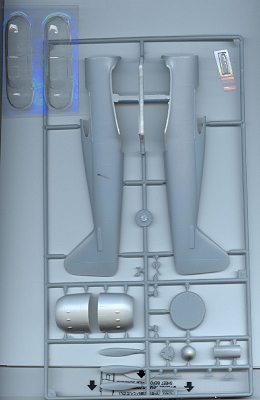 |
The MB-155 is the first Classic
Airframes offering on which I lay my hands onto. Having already built three
limited-run kits, I must say that this one is a couple of notches above the
others. 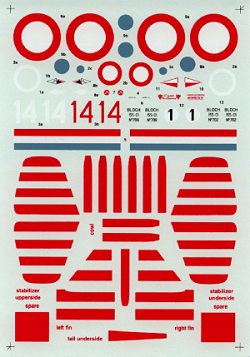
In a conventional box, two sprues of light grey styrene are bagged together, with the various resin detail parts (cast by CMK) placed in two more bags. The parts are clean, with surprisingly few flash for a limited-run kit. None of the parts are warped or broken, and no sink holes mar the surface of the plane.
The resin bits are well cast, with easily removed pouring blocks for the majority of them, but the seat will be very fun to remove from the block, with supporting struts blocking the way for an easy saw pass. The bits include a complete engine (15 cylinders and a block), the cockpit walls and details, the wheel wells, the wheels (which are slightly bulged) and the rocker bumps on the cowlings.
The canopy is provided as a vac formed part, along with a spare. The same is true for the landing light cover.
The decals were printed by Microscale, and are exactly what you would expect from them. The first scheme is for a pre-Armistice aircraft from the GC II/8 in June of 1941, and the other one is a plane from the same group, however under the Vichy regime in 1941-1942. This one has the red an yellow ID stripes on the nose and tail.
|
CONCLUSIONS |
Like any limited-run kits, this MB-155 will not be a walk in the park, but by taking your time, you should be able to come through with a fine representation of this French fighter. I wouldn’t be afraid to undertake it as my first limited-run project.
|
REFERENCES |
GREEN, William. Warplanes of the Second World War, “Fighters Volume One”, Macdonald, London, 1960.
Editors Note: another good reference is the new 'French Fighters in Action' from Squadron Signal, 2002
If you would like your product reviewed fairly and quickly by a site that has well over 150,000 visitors a month, please contact me or see other details in the Note to Contributors.